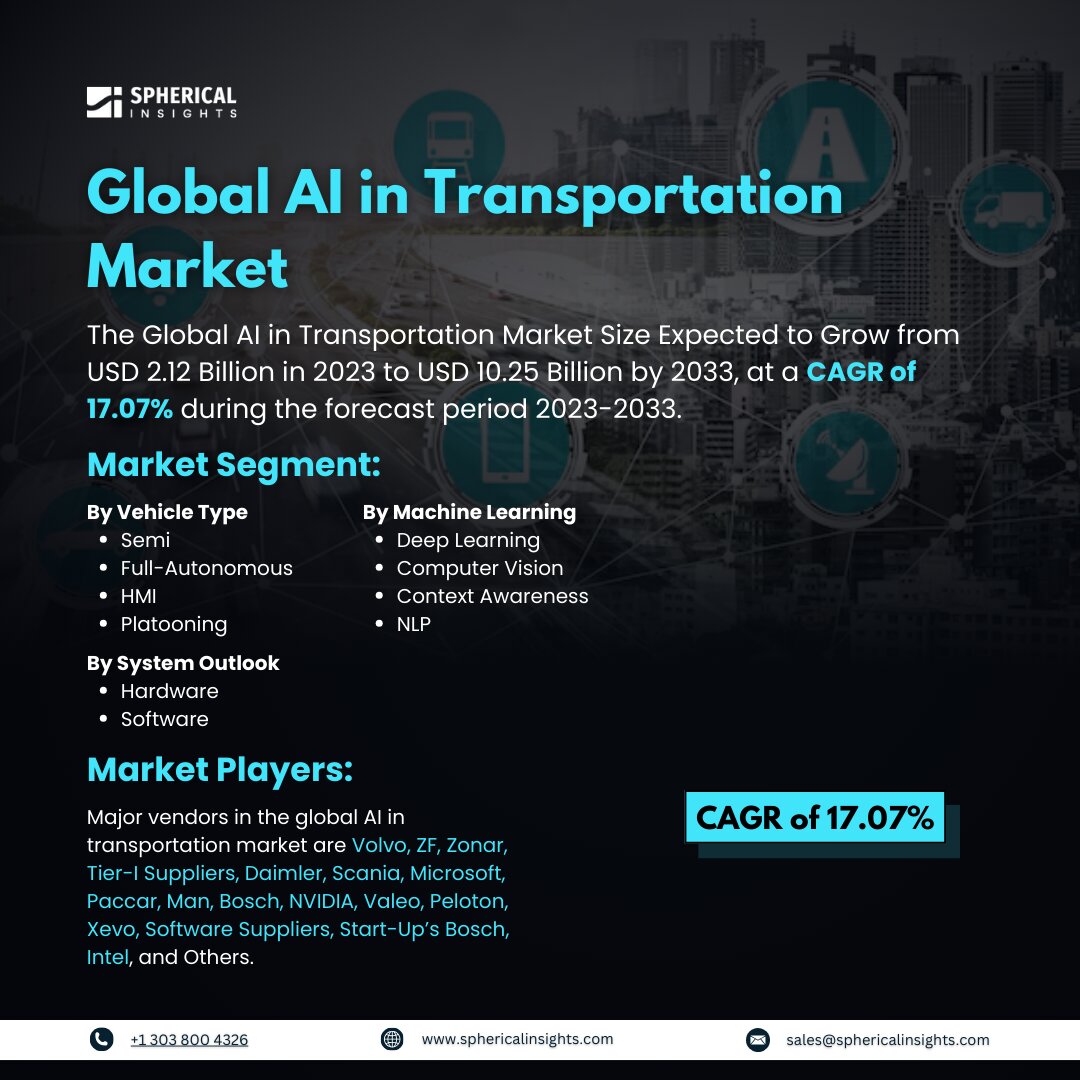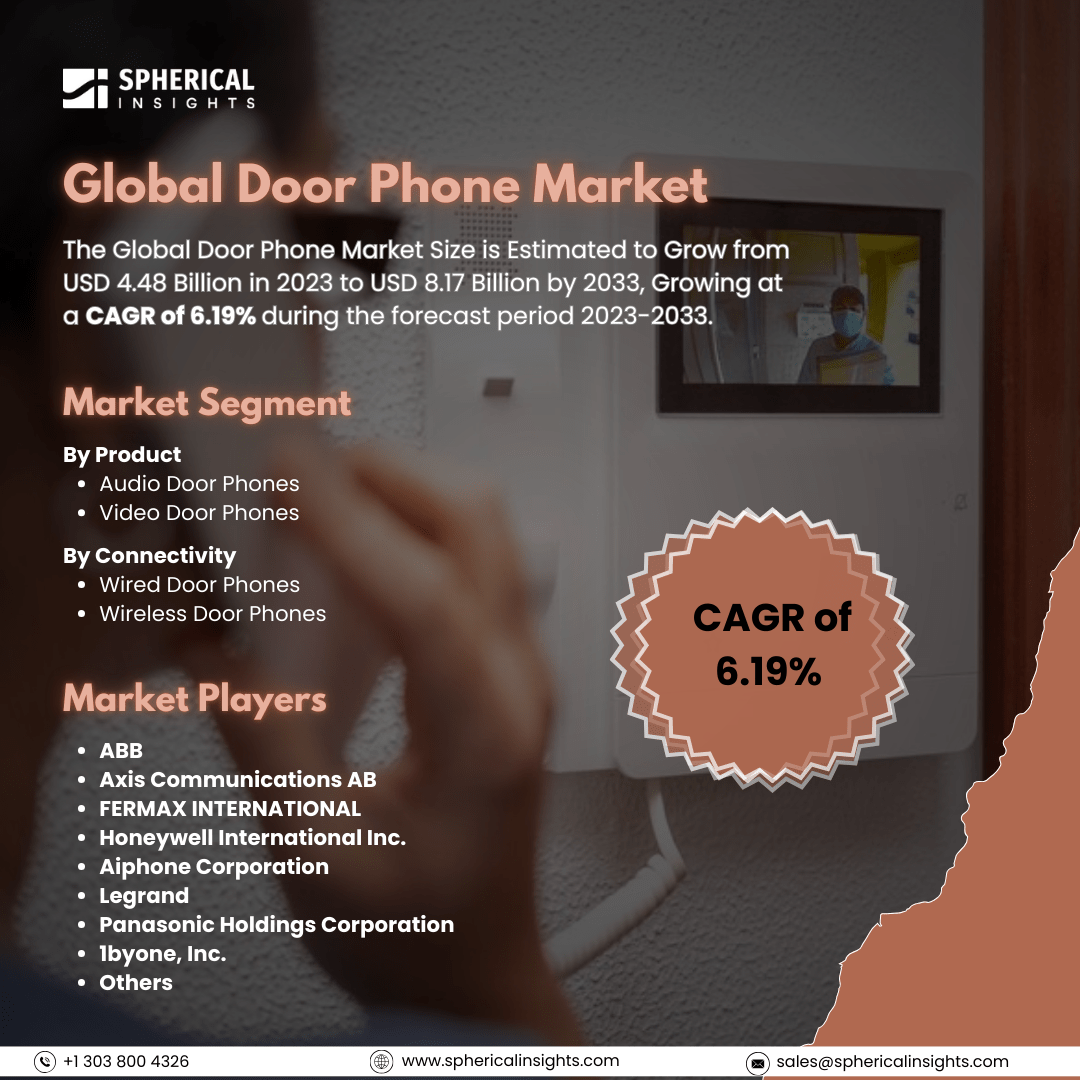Global AI in Transportation Market Size to Exceed USD 10.25 Billion by 2033
According to a research report published by Spherical Insights & Consulting, the Global AI in Transportation Market Size Expected to Grow from USD 2.12 Billion in 2023 to USD 10.25 Billion by 2033, at a CAGR of 17.07% during the forecast period 2023-2033.
Browse 210 market data Tables and 45 Figures spread through 190 Pages and in-depth TOC on the Global AI in Transportation Market Size, Share, and COVID-19 Impact Analysis, By Vehicle Type (Semi & Full-Autonomous, HMI, Platooning), By Machine Learning (Deep Learning, Computer Vision, Context Awareness, NLP), By System Outlook (Hardware, Software), and By Region (North America, Europe, Asia-Pacific, Latin America, Middle East, and Africa), Analysis and Forecast 2023 – 2033
Artificial intelligence (AI) in the transportation market refers to the application of AI technologies for improving various areas of logistics and transportation. The objective is to improve the transportation sector's overall user experience, safety, sustainability, and efficiency. AI has been implemented into a variety of transportation systems, including public transportation, railroads, air traffic control, maritime shipping, and even systems for sharing bicycles and scooters. AI supports intelligent traffic control, predictive maintenance, route optimization, and intelligent parking systems are a few examples of these applications. The market of AI in transportation is gradually increasing due to increasing developments in the automobile sector as well as consumer preferences rapidly shifting towards electrification which welcomes new EVs and Hybrid vehicles. In addition, the use of AI gives a better experience for passengers in terms of a luxurious, assists environmental sustainability in terms of fuel consumption control, and reduces maneuverer force during short-distance destinations. However, the market is restricted by several variables such as uncertainty during rides in terms of engine performance, and power strain, so such kinds of variables indirectly impact passenger safety regards. Also, they require high expenses for implementation and regular maintenance.
The full autonomous segment is expected to hold the largest share of the global AI in the transportation market in the forecast period.
On the basis of the vehicle type, the global AI in transportation market is categorized into semi-full-autonomous, HMI, and platooning. Among these, the full autonomous segment is expected to hold the largest share of the global AI in the transportation market in the forecast period. The segment expansion contributed to market revenue share due to the high level of precision that assisted the vehicle's overall performance. Especially long hauling transit like cargo vans or trucks designed with features such as predictive route optimization, without any uncertainty of technology. The automakers and technology firms teamed up for collaborative projects that give exposure to market growth.
The deep machine learning is anticipated to hold the largest share of the global AI in the transportation market in the forecast period.
On the basis of machine learning, the global AI in transportation market is divided into deep learning, computer vision, context awareness, and NLP. Among these, the deep machine learning is anticipated to hold the largest share of the global AI in transportation market in the forecast period. The growth of the segment is contributing to the market expansion due to the combination of conventional neural and artificial neural connectivity. This segment is an immersive database balanced with both artificial and conventional neural algorithms. The features of understanding road sign recognition, pedestrian, image classification, and object visualization empowered the drivers functionalities.
The hardware segment is projected to hold the largest share of the global AI in transportation market in the forecast period.
On the basis of the system outlook, the global AI in transportation market is classified into Hardware and software. Among these, the hardware segment is projected to hold the largest share of the global AI in transportation market in the forecast period. This segment growth gives exposure to market revenue because of including sensors, detectors, and cameras are attached to AI or IoT things which provide real time data that enables driving capabilities. The increasing research for self driving vehicles put attention to the rising need for such kinds of hardware. In addition, the collaborative project related to OEM in case of testing and compliance with the quality standards can boost the advanced hardware utility.
North America is projected to hold a significant share of the global AI in transportation market in the forecast period.
The region has made its dominant position at the worldwide level because of the robust infrastructure for the automobile industry and well established in supplies chain network. The regional government is continuing investment in novel innovative merchandise and R&D. The region has the presence of key automotive players such as Tesla, GM, and Ford making collaborative assignments with techno companies like Google, Intel, and Microsoft which boost the market expansion. Moreover, increasing the adoption of EVs can drive market exposure.
Asia Pacific is predicted to grow at the fastest pace in the global AI in transportation market in the forecast period. The region is undergoing rapid development in the automobile industry contributing it a fast developing marketplace. Also, major countries like India, China, and South Korea have increasingly immersive substantial investments in the integration of cutting edge technology helps them grow at a rapid pace.
Competitive Analysis
Major vendors in the global AI in transportation market are Volvo, ZF, Zonar, Tier-I Suppliers, Daimler, Scania, Microsoft, Paccar, Man, Bosch, NVIDIA, Valeo, Peloton, Xevo, Software Suppliers, Start-Up’s Bosch, Intel, and Others.
Key Target Audience
- Market Players
- Investors
- End-users
- Government Authorities
- Consulting and Research Firm
- Venture capitalists
- Value-Added Resellers (VARs)
Recent Development
- In July 2024, Waabi introduced a Generative AI for fully driverless autonomous trucking. Their solution, called the Waabi Driver, leverages advanced AI technologies to enable trucks to operate safely and efficiently without human intervention. Waabi is introducing this truck with NVIDIA to integrate the next-generation NVIDIA DRIVE Thor platform, which provides the powerful computing capabilities needed for this technology.
- In March 2024, L&T Technology Services (LTTS) teamed up with Intel to develop scalable edge-AI solutions aimed at enhancing traffic management and emergency safety in smart cities and transportation sectors. Intel's Edge Platform, which includes built-in AI runtime powered by OpenVINO, LTTS will enable on-premises and hybrid AI scenarios for traffic management. This collaboration is expected to improve road safety, accident prevention, and overall mobility.
Market Segment
This study forecasts revenue at global, regional, and country levels from 2023 to 2033. Spherical Insights has segmented the global artificial intelligence in transportation market based on the below-mentioned segments:
Global Artificial Intelligence in Transportation Market, By Vehicle Type
- Semi
- Full-Autonomous
- HMI
- Platooning
Global Artificial Intelligence in Transportation Market, By Machine Learning
- Deep Learning
- Computer Vision
- Context Awareness
- NLP
Global Artificial Intelligence in Transportation Market, By System Outlook
Global Artificial Intelligence in Transportation Market, Regional
- North America
- Europe
- Germany
- Uk
- France
- Italy
- Spain
- Russia
- Rest of Europe
- Asia Pacific
- China
- Japan
- India
- South Korea
- Australia
- Rest of Asia Pacific
- South America
- Brazil
- Argentina
- Rest of South America
- Middle East & Africa
- UAE
- Saudi Arabia
- Qatar
- South Africa
- Rest of the Middle East & Africa



